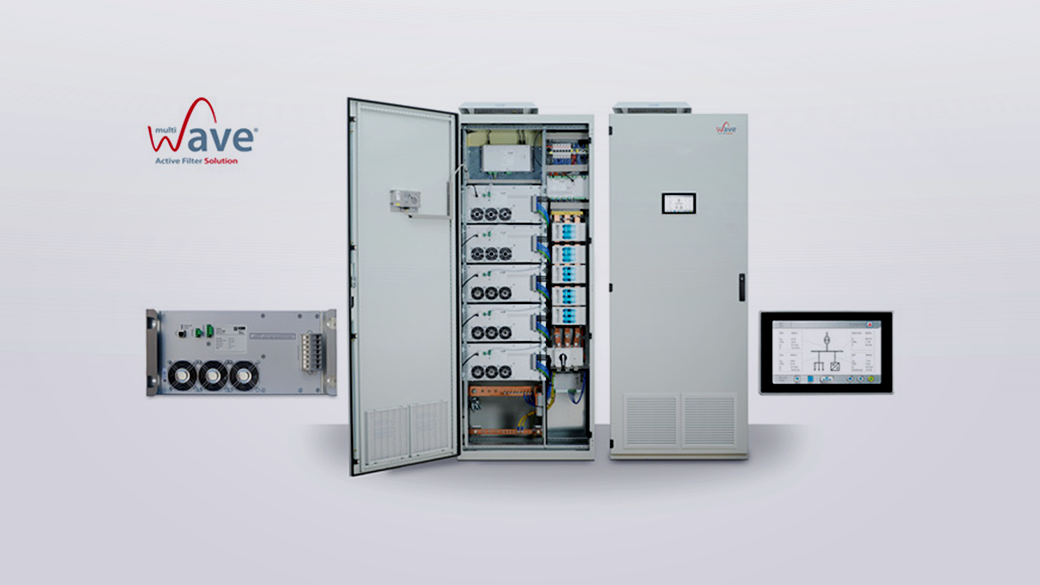Active harmonic filter – multiwave
Overview
multiwave active significantly increases operational safety The loads in industrial networks are increasingly dominated by a large number of small and large converters. In this context, two effects can be observed. Due to the falling number of motors operated directly on the grid, the need for inductive fundamental reactive power is decreasing. At the same time, harmonic currents are increased. The impedance of the network transformer plays a decisive role. A large part of the harmonic voltage is created here, leading to faults in all consumers. This results in unreliable operation of the devices and an increased number of malfunctions.

Product detail
- Harmonic compensation up to the 50th harmonic
- Easy expansion thanks to modular system
- Current- or voltage-regulated control
- Automatically adapts to changing conditions in operation
- Reactive power compensation, phase-selective, inductive, and capacitive
- Load balancing, compensation for phase shifts
- Robust, reliably, and with higher temperature range up to 50°C without derating
- Harmonic filtering, selective in percentage or limits from the standard
| General technical data | |
|---|---|
| Rated voltage AC | 400 V (max. 415 V) ±10% |
| Network frequency | 50 / 60 Hz |
| Peak current | 2x rated current |
| Cable connection | 3-phase + PE + N/PEN, neutral conductor connection is required (Network configuration: TN) |
| Compensation | 3-wire operation: External conductor, symmetrical and asymmetrical (positive and negative sequence network) 4-wire operation: also has neutral conductor (positive, negative, and zero sequence network) |
| Compensation | 1st – 51st harmonic (50 Hz) // 1st – 41st harmonic (60 Hz) // 1st – 51st harmonic (50 Hz) // 1st – 41st Harmonic (60 Hz) All harmonics can be filtered at the same time |
| Additional functions | – Dynamic reactive power compensation – Active and reactive power balancing (negative sequence network up to 60%, zero sequence network up to 30% rated current) – Voltage stabilization through Q(U) control – Flicker compensation – Neutral conductor load reduction |
| Operating voltage AC | 400 V |
| Power dissipation | < 2.6% of compensation power maximum, < 2.6% of compensation power maximum, < 2.3% in typical operating, < 0.7% in idle speed, < 100 W in standby |
| Switching frequency | 20 kHz (low-loss version) |
| Controls | Internal control computer with two digital signal processors |
| Device setup and display | Via internal web servers (TCP/IP) and PC, SD card, or Anybus interface (field bus interface) |
| Response time | << 1ms |
| Interfaces | – Ethernet (TCP/IP) – Various field bus systems via Optional Anybus plug-in module (e.g. Profinet, Modbus TCP) – 4x digital outputs: 250 VAC (3 A) / 110 VDC (0.7 A) / 24 VDC (1 A), potential and configurable – 4x digital inputs: 24 VDC (10 mA), configurable for remote control and easy additional parameter adjustment |
| Current transformers | 3-phase current measurement, xx/5 A or xx/1 A (configurable) The required current transformers are not included, 15 VA, class 1 or better recommended |
| Inverters | 3-level IGBT with intermediate voltage circuit (electrolytic capacitors) |
| Ambient conditions | – Maximum ambient temperature without reduced performance: 40°C – Recommended ambient temperature for continuous operation: < 25°C – Minimum operating temperature: 0°C – Relative humidity: maximum 95% – Transport/storage: -20° C … 70 °C |
| Overvoltage category | CAT III, 300 V |
| EMC class | Standard: EN 55011, class A1 (industrial environment), optional: Class B (residential area) |
| Standards | EN 50178, EN 61439-1, EN 61439-2, EN 61-6-2, EN 61000-6-4, EN 55011 |